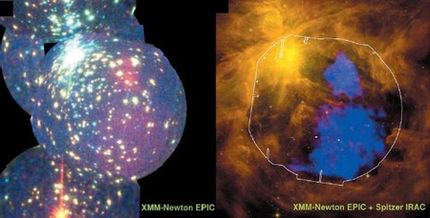February 7, 2008 feature
Million-Degree Plasma May Flow throughout the Galaxy

On a large scale, the Milky Way is considered to be a vast cold region punctured with isolated hot clouds and star clusters. While much of this space is cold and empty, researchers have recently discovered the phenomenon of funneling hot plasma. Flowing plasma may funnel from one region to another through empty space, connecting otherwise isolated clouds and clusters throughout the galaxy.
Researcher Manuel Güdel at the Paul Scherrer Institut in Switzerland and colleagues from Switzerland, France and the US have recently observed the plasma flow phenomenon for the first time in the Orion Nebula. Based on images taken with an x-ray satellite called the XMM-Newton, the researchers observed the existence of a million-degree plasma flowing from the nebula into the adjacent interstellar medium, and then into the neighboring superbubble Eridanus.
“Although there has been a theoretical model that predicted hot gas bubbles blown by just one massive star, such has not been detected until we found confirmation in the Orion Nebula,” Güdel told PhysOrg.com. “We didn't look for it - we actually found this diffuse emission by chance while looking at the many stellar x-ray point sources in the field. As previous researchers have not reported diffuse x-ray emission from such star-forming regions but were rather arguing against its presence, we were indeed surprised to find such prominent emission across large regions of the nebula.”
The Orion Nebula hosts several thousand young stars (less than a few million years old), and almost every one of these stars vigorously emits x-rays. The satellite’s cameras observed the x-ray stars, but it also picked up a separate, fainter emission in the extended parts of the nebula. Upon investigating the spectrum of this emission, the scientists discovered that the energy indicated a million-degree plasma. A dense veil of neutral gas probably hid the hot plasma from previous observations, such as those by the Chandra X-ray Observatory, which didn’t detect a thing.
Not only did the researchers discover a new phenomenon, but they think they know what causes the super-hot, large-scale plasma. As the scientists explain, the energy required to heat such a monstrous gas is “severe.” The young stars in the Orion Nebula don’t seem capable of hosting such a hot, energetic structure.
But the researchers think that sufficient energy could come from the high velocity winds emitted by stars in a dense region in the nebula called the Trapezium – a small group of massive stars that is almost solely responsible for the optical light we see from the Orion Nebula. The winds from the Trapezium stars colliding with the surrounding gas could generate enough kinetic energy to create shock waves that can heat up the gas to millions of degrees.
In most cases, such a hot plasma would stay confined in its cavity, contained by gases and dust that don’t mix with the plasma. But in this case, the plasma and the surrounding cooler gas have very similar pressures, and this near-pressure equilibrium makes it possible for the plasma to leak out of its cavity and into cool interstellar space. Flowing at a velocity of a few tens of kilometers per second, it likely heads toward the nearby Eridanus superbubble, replenishing this vast interstellar region with hot gas.
The discovery of the pervading plasma in Orion is unusual because such a large-scale plasma was previously thought to require large groups of massive stars for its energy source, which aren’t found in the Orion Nebula. If hot plasma can occur in a region with a small number of massive stars, the phenomenon might be more common in the galaxy than astronomers previously thought.
“Hot gas has been seen in some extremely massive star-formation regions, and some of this gas might have been produced by supernova explosions,” said Güdel. “However, the Orion Nebula is the first region of its (more modest) kind that shows this phenomenon, and there is no supernova that can account for it. Such more modest regions of star formation are naturally more frequent in the galaxy than the more extreme cases. Therefore, we believe that plasma outflows from star-forming regions are widespread.”
As the researchers learn more about the possibilities that can occur in our galaxy, they also better understand the early history of our Sun and our Solar System, and maybe others like it.
“The hot gas and the X-rays that it emits interact with the cool, molecular environment in which stars form,” said Güdel. “It may influence the environment of stars – for example, circumstellar accretion disks in which planets form – by contributing to the ionization of those disks. Such effects need further study, though.”
More information: Güdel, Manuel, Briggs, Kevin R., Montmerle, Thierry, Audard, Marc, Rebull, Luisa, and Skinner, Stephen L. “Million-Degree Plasma Pervading the Extended Orion Nebula.” Science, Vol. 319, 18 January 2008.
Copyright 2008 PhysOrg.com.
All rights reserved. This material may not be published, broadcast, rewritten or redistributed in whole or part without the express written permission of PhysOrg.com.





















